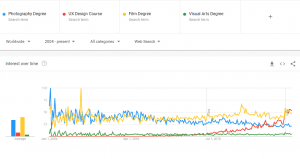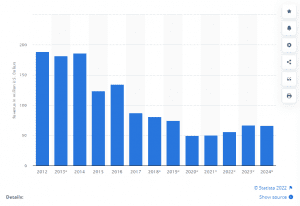A Critical Analysis of Pursuing Advanced Education in Photography
In 2017 I visited the School of Visual Arts in New York, to see if their Graduate program in photography was any good. I talked to a few professors and some students. Student life revolved around a bunch of New York Buildings—I could compare to the Benilde campus and the School of Design and Arts at Taft Ave. in Manila. I interviewed a student to tell me about the coursework. It was mostly Photoshop, printing, and story-telling. As for potential opportunities I could unlock with the network of students and professors at SVA? Nothing fantastic. When asked about it—or if he knew anyone that had successfully broken into the commercial photography industry in big ol’ New York—he literally had nothing to share.

He cycled from Brooklyn and worked part-time at an art gallery as an aide. Frankly, I anticipated a higher-ranking role. He encouraged me to check out his Instagram account to view his projects, which mainly consisted of stitched and edited images, quite similar to what my creative director in Manila did for publishing. If this student represented a customer testimonial for the school, it would have been an awful example. I couldn’t help but laugh, realizing the entire situation was a farce, particularly when he stated that the primary focus was mostly on photo editing. You can find my opinions on obtaining a photography degree here.
The Value doesn’t translate
The program director I met with, gave the impression that the curriculum taught revolutionary ideas and incorporated cutting-edge technologies prevalent in the photography industry, all developed by the institution. I returned home with a bag full of peculiar school-published materials, mainly featuring the program director’s name in the bylines. Let me assure you, it’s all nonsense. Nothing but smoke and mirrors, with no real substance. The network was abysmal, and the subjects were uninteresting. I was not impressed in the slightest. In my view, pursuing an MBA or even a degree in UI/UX would be a more fitting choice to address the demand for enhanced customer experiences in numerous prominent global businesses and markets, compared to an MFA. While creativity will always be a subjective matter, a framework or methodology will consistently serve as a starting point for delivering the best outcomes. Unfortunately, the SVA MFA program seems to lack this, and if they do offer it, they certainly don’t emphasize it.

Success is found in business acumen and skills beyond the visual arts
When it comes to pursuing a graduate degree in the arts, such as photography, there is a prevalent notion that it will inevitably lead to a successful career. However, the reality is far from this idealistic view. In fact, research suggests that a master’s degree in the arts may not guarantee financial success in the field.
Several reports and studies suggest a graduate degree in the arts may not guarantee higher salaries or more job opportunities. Moreover, the job market in the arts industry is highly competitive, and there are only limited high-paying jobs available. Therefore, it is crucial to ask oneself whether the cost of pursuing a master’s degree in photography is worth the investment.
Here’s an article showing how to bridge the gap. It also shows that 90% of people who study the arts end up in a different field.
Another consideration is the importance of networking and building a strong portfolio in the arts industry. While a master’s degree may equip an individual with technical and creative skills, it does not guarantee exposure or recognition. Ultimately, it is the quality of work and networking that plays a significant role in securing clients and building a successful career in the arts.
A recent study has found that a staggering 9% of Americans with a master’s degree in photography saw little to no increase in their employability, with a disappointing increase of less than 3%. These results are a stark wake-up call to institutions offering graduate photography programs, revealing a critical need to overhaul their approach to curriculum design and student success.
It’s time for institutions to prioritize cutting-edge technology, and innovative concepts, and a comprehensive framework that includes building good business acumen must be added to ensure graduates’ success. Unless schools offering photography degrees shift their focus to something more groundbreaking and impressive, these departments will soon be removed from their prospectus.
Aspiring photographers need access to a curriculum that goes beyond the basics and prepares them for the dynamic and ever-changing industry, now dominated by AI. The current approach to graduate photography programs is outdated and fails to keep up with the times.
This is a pressing issue that affects students’ futures and the sustainability of the industry. It’s time for directors of undergraduate and graduate programs to take action and revamp their approach. Otherwise, pursuing a graduate degree in photography may be nothing more than a mirage, and students will continue to suffer the consequences. It’s time for institutions to step up and prioritize the needs of their students to ensure their success in the ever-changing landscape of photography.
In conclusion, a graduate degree in photography and the arts may not necessarily lead to financial success or guarantee job opportunities. It is crucial to weigh the cost of pursuing a master’s degree against the potential benefits and consider other ways to build a strong portfolio and network in the industry.




